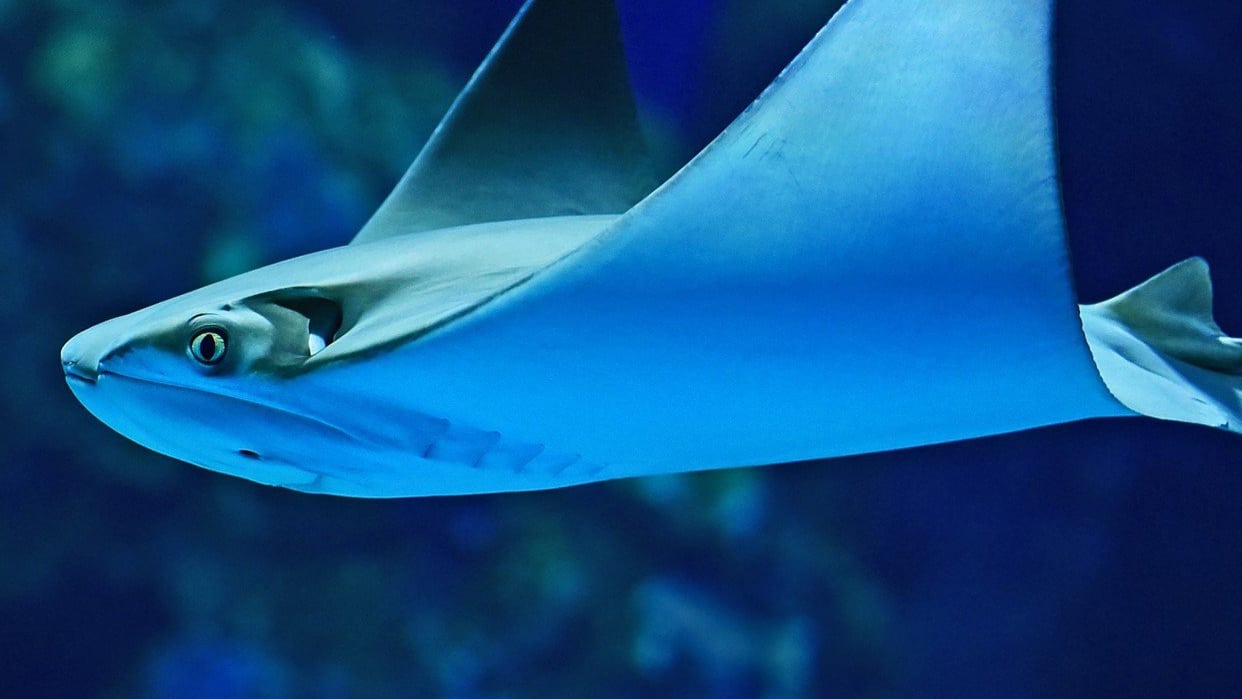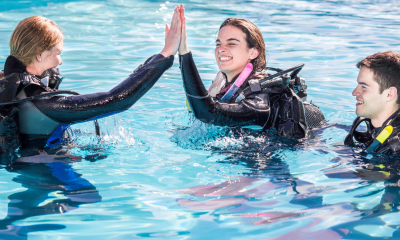Marine Life & Conservation
Creature Feature: Cownose Ray

 In this series, the Shark Trust will be sharing amazing facts about different species of sharks and what you can do to help protect them.
In this series, the Shark Trust will be sharing amazing facts about different species of sharks and what you can do to help protect them.
This month we’re showing off one of the lesser-known rays: the Cownose Ray, so-called due to the two lobes on the top of their head. When viewed from above, these lobes resemble a cow’s nose.
The Cownose Ray is a species of eagle ray (which also includes the Bull Ray, Banded Eagle Ray and others). They are often mistaken for sharks from the beach, due to the tips of their fins sticking out of the water (resembling the dorsal fin of a shark).
Typically, brown-backed, with a whitish or yellowish belly, it’s the Cownose Ray’s shape that is the key identifier; with its broad head, wide-set eyes, and pair of lobes on its subrostral (in front of the “face”) fin.
They typically feed on clams, oysters and other invertebrates. Preferring to feed in early morning or late afternoon, when waves are calm, and visibility is good. They uncover their prey by stirring up the sand and sediment with their wings. Once located, Cownose Rays can create a vacuum with their mouths to suck up their prey from the seabed. They have a set of concrete-like dental plates which are perfect for crushing shells . In addition to their strong mouths, the Cownose Ray also have a few defensive abilities too. They are stingrays and have a barb on the base of their tails to defend themselves, which produces a toxin that injures the aggressor.
Photo by David Clode on Unsplash
Social creatures, they typically swim in groups. They also migrate extremely long distances, often in schools of up to 10,000. Their migration is from the Gulf of Mexico to Trinidad, Venezuela and Brazil. Atlantic migration consists of the rays moving north in late spring and moving south in late autumn. Even though scientists can track their migration well (even from airplanes as the schools can be seen from the sky!), the reason for their migration is still a mystery. It’s unknown if it’s due to feeding or a pre-mating activity
They reach sexual maturity at 6 to 7 years and can live up to ~21 years. Females give birth to live young, following a11-12 months gestation period.
They are listed as Vulnerable, due to extensive overfishing – mainly in the Caribbean. Whilst the meat from Cownose Rays is not in-demand and thus they are not targeted by largescale operations. They are overfished in the Caribbean and along the Venezuelan coast – with declines in the population of up to 49% in the last 43 years.
SCIENTIFIC NAME: Rhinoptera bonasus
- FAMILY: Rhinopteridae
- MAXIMUM SIZE: ~110 cm wide
- DIET: Clams, oysters, hard clams, crustaceans and other invertebrates
- DISTRIBUTION: Western Atlantic from southern New England to northern Florida (USA) and throughout the Gulf of Mexico, migrating to Trinidad, Venezuela, and Brazil.
- HABITAT: Brackish and marine habitats, usually in shallow waters but have been found up to a depth of 60 m.
- CONSERVATION STATUS: Vulnerable
Cownose Ray Activity BundleDiscover more with the Cownose Ray Activity Bundle. Brought to you by award-winning outdoor education provider – The Great Out-Tours. Created for children and adults in care homes, these bundles of fun will provide hours of entertainment. Wordsearches, jigsaws, arts and crafts, educational videos, a family quiz and so much more. All jammed packed into this bundle for just £1, with 15p going to the Shark Trust! |
For more amazing facts about sharks and what you can do to help the Shark Trust protect them visit the Shark Trust website by clicking here.
Header Image: David Clode on Unsplash
Blogs
Invitation from The Ocean Cleanup for San Francisco port call

6 years ago, The Ocean Cleanup set sail for the Great Pacific Garbage Patch with one goal: to develop the technology to be able to relegate the patch to the history books. On 6 September 2024, The Ocean Cleanup fleet returns to San Francisco bringing with it System 03 to announce the next phase of the cleanup of the Great Pacific Garbage Patch and to offer you a chance to view our cleanup system up-close and personal.
We look forward to seeing you there.
To confirm your presence, please RSVP to press@theoceancleanup.com
PROGRAM
Join The Ocean Cleanup as our two iconic ships and the extraction System 03 return to San Francisco, 6 years and over 100 extractions after we set sail, to create and validate the technology needed to rid the oceans of plastic.
Our founder and CEO, Boyan Slat, will announce the next steps for the cleanup of the Great Pacific Garbage Patch. Giving you a chance to view our cleanup system and the plastic extracted.
Hear important news on what’s next in the mission of The Ocean Cleanup as it seeks to make its mission of ridding the world’s oceans of plastic an achievable and realistic goal.
Interviews and vessel tours are available on request.
PRACTICALITIES
Date: September 6, 2024
Press conference: 12 pm (noon)
Location: The Exploratorium (Google Maps)
Pier 15 (Embarcadero at Green Street), San Francisco, CA
Parking: Visit The Exploratorium’s website for details.
RSVP: press@theoceancleanup.com
Video & photo material from several viewing spots around the bay
We look forward to seeing you there!
ABOUT THE OCEAN CLEANUP
The Ocean Cleanup is an international non-profit that develops and scales technologies to rid the world’s oceans of plastic. They aim to achieve this goal through a dual strategy: intercepting in rivers to stop the flow and cleaning up what has already accumulated in the ocean. For the latter, The Ocean Cleanup develops and deploys large-scale systems to efficiently concentrate the plastic for periodic removal. This plastic is tracked and traced to certify claims of origin when recycling it into new products. To curb the tide via rivers, The Ocean Cleanup has developed Interceptor™ Solutions to halt and extract riverine plastic before it reaches the ocean. As of June 2024, the non-profit has collected over 12 million kilograms (26.4 million pounds) of plastic from aquatic ecosystems around the world. Founded in 2013 by Boyan Slat, The Ocean Cleanup now employs a broadly multi-disciplined team of approximately 140. The foundation is headquartered in Rotterdam, the Netherlands, and opened its first regional office in Kuala Lumpur, Malaysia, in 2023.
Find out more about The Ocean Cleanup at www.theoceancleanup.com.
Marine Life & Conservation
SHARK MONTH ARRIVES AT ROYAL WILLIAM YARD, PLYMOUTH

A shark has been spotted approaching Royal William Yard in Plymouth, much to the surprise of swimmers, paddleboarders and onlookers.
With its distinctive dorsal fin cutting through the water, the sizeable shark swam along the coastline, before turning to head inland towards Firestone Arch at Royal William Yard. The appearance drew a crowd, who were captivated for more than an hour by the unusual sight – and it was all caught on video.
The shark is one of many expected sightings at Royal William Yard over the coming weeks… because today marks the start of Shark Month!
In reality, the ‘shark’ spotted along the Plymouth shoreline was actually a custom-made model, created by the team at Royal William Yard and sailed underwater by Caroline Robertson‑Brown from the Shark Trust, who donned scuba diving gear for the occasion.
The stunt took place to launch Shark Month in style and draw attention to the work of the leading international conservation charity, which is based in Britain’s Ocean City. Spectators were reassured that the water was safe and many entered into the spirit of the performance, swimming or sailing alongside the shark.
Shark Month will take place across Royal William Yard throughout July and will feature an extravaganza of art, entertainment and advocacy for everyone to enjoy. The packed programme of events starts with an art exhibition and ends with a trip on paddleboards with shark experts – with everything from a shark quiz to a Jaws screening in between.
Paul Cox, CEO of the Shark Trust, said: “There are often assumptions and misconceptions when it comes to sharks. This was certainly the case with the shark spotted at Royal William Yard! While the British coastline is home to many species of shark, this was not one of them. However, we’re thrilled it caught people’s attention, because seeing a shark is a special and memorable moment. That is precisely why we want to celebrate these incredible creatures, highlight the need for conservation, and ask for help to safeguard their future.”
For more information about Shark Month at Royal William Yard, visit the Shark Trust Website.
Images and video: Jay Stone
-

 Blogs2 months ago
Blogs2 months agoDiving With… Nico, Ocean Earth Travels, Indonesia
-

 News1 month ago
News1 month agoMurex Bangka Announce New Oceanfront Cottages & Beachfront Dining
-

 Blogs2 months ago
Blogs2 months agoA new idea in freediving from RAID
-

 Marine Life & Conservation1 month ago
Marine Life & Conservation1 month agoIceland issue millionaire whale hunter a licence to murder 128 vulnerable fin whales
-

 Marine Life & Conservation2 months ago
Marine Life & Conservation2 months agoThe Shark Trust Great Shark Snapshot is back
-

 News3 months ago
News3 months agoCharting New Waters; NovoScuba Goes Global with the Launch of their Revolutionary Dive Training Agency!
-

 Gear News1 month ago
Gear News1 month agoNew Suunto Ocean – a dive computer and GPS sports watch in one for adventures below and above the surface
-

 Marine Life & Conservation Blogs2 months ago
Marine Life & Conservation Blogs2 months agoBook Review: Plankton














